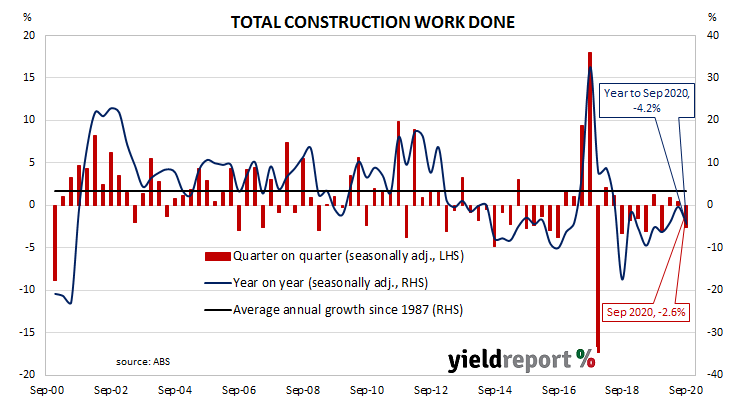Summary: Construction spending contracts again; fall slightly larger than expected; June quarter revised up, now positive; underlying weakness, COVID-related disruptions still affecting sector; residential, non-residential building, engineering all down; September quarter GDP growth likely to be dragged down by result.
Construction expenditure increased substantially in Australia in the early part of last decade following a more-steady expansion through the 2000s. A large portion of the increase came from the commissioning of new projects and the expansion of existing ones to exploit a tripling in price of Australia’s mining exports in the previous decade. The return to “normal” investment levels is still continuing.
According to the latest construction figures published by the ABS, total construction in the September quarter fell by 2.6%. The decline was slightly larger than the 1.9% contraction which had been expected and in contrast to the June quarter’s 0.5% increase after it was revised up from -0.7%. On an annual basis, the growth rate deteriorated from June’s revised figure of -0.3% to -4.2%.
“Activity in the sector declined on underlying weakness evident from mid-2018 and COVID-related disruptions, in particular, Victoria’s second lock-down,” said Westpac senior economist Andrew Hanlan.

Long-term Commonwealth Government bond yields finished the day moderately higher, broadly following overnight movements in US Treasury yields. By the end of the day, 10-year and 20-year yields each finished 4bps higher at 0.93% and 1.56% respectively. The 3-year ACGB yields remained unchanged at 0.17%.
In the cash futures market, expectations of a change in the actual cash rate, currently at 0.05%, barely changed. At the end of the day, contract prices implied the cash rate would slip a little closer to zero in December and then settle at around 0.04% through 2021.
Residential building construction contracted by 1.0%, an improvement from the previous -3.9% after revisions. On an annual basis, expenditure in this segment was 8.9% lower than the September 2019 quarter, higher than the June quarter’s comparable figure of -9.9% after revisions.
Non-residential building spending decreased by 3.4%, a larger contraction than the previous quarter’s revised figure of -1.5%. On an annual basis, expenditures were 4.5% lower than the September quarter of 2019. The June quarter’s comparable figure was +7.4% after revisions. Westpac’s Hanlan said Private non-residential work had “tumbled” and he expected “further falls ahead.”

